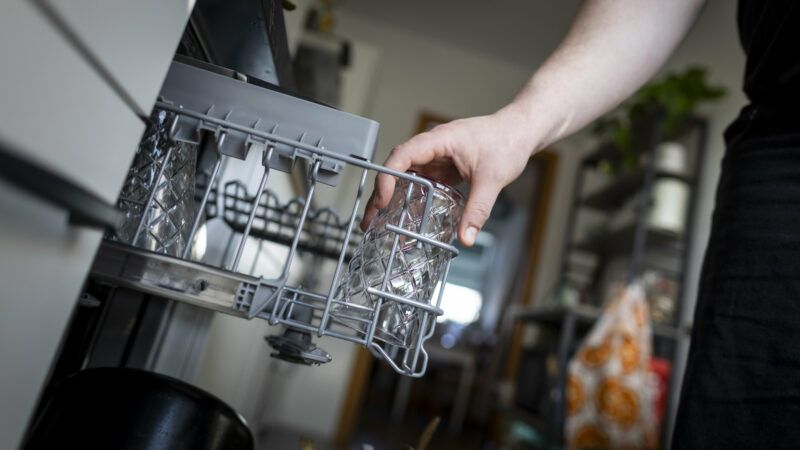Donald Trump's Energy Department Saved Your Appliances
Decades of efficiency mandates have made dishwashers weaker, A.C. units feebler, and appliances more expensive. A new rollback offers a rare win for function over dogma.

Last week, President Donald Trump's administration turned its chainsaws on the Department of Energy (DOE), cutting, canceling, or pausing a handful of onerous regulations set to hobble household and commercial appliances. Anyone who's coughed up a small fortune for a barely functional machine lately knows the stakes.
My 30-year-old Bosch dishwasher was a marvel—efficient, precise—scouring dishes in 45 minutes like a Prussian drill sergeant on a deadline. Last month, it died. I dropped $800 on a sleek successor, expecting progress. Instead, I got a two-hour grease-smearing farce that leaves forks, like my optimism, caked in the grime of dashed hopes—a victim of the DOE's regulatory straitjacket.
My 1979 brick ranch creaks on into senescence, its heater, air-conditioning, fans, and water heater—bastions of a bygone era of appliance liberty—teetering. Replacing them likely means paying thousands of dollars for lesser-able machines. That's been the story for decades: as tech leaps forward, appliances regress. Until now.
In February, Trump's DOE postponed three Biden-era efficiency rules related to central A.C. and heat pumps, walk-in coolers and freezers, and gas tankless water heaters. It also carved a special regulatory category, freeing tankless heaters from Biden's near-ban. Just last week, the DOE cut four more rules outright—impacting ceiling fans, dehumidifiers, external power supplies, and the electric motors that power almost everything. This isn't just red tape slashed—it's a rare win for choice and function over dogma. What exactly did we dodge? A lot.
Take electric motor mandates—these rules hit everything from your blender to your garage compressor. They aimed to tighten already-strict regulations and expand them to even more motors in everyday appliances. Ostensibly, the goal was to reduce electricity use and emissions. Sounds noble—until you realize what it does to the products we actually use.
These motors skimp on low-end torque, hobbling appliances that need a quick jolt—think A.C. units gasping to start or a blender stalling on ice. They're slower to respond and less precise. And because they require rare earth metals and heavier materials, they make devices bulkier—your cordless drill suddenly feels like a lead pipe.
Worse, these high-efficiency designs come with a high-efficiency price tag. Costs shoot up, and U.S. manufacturers—after burning capital on redesigns and retooling—struggle to compete with countries that don't play by the same regulatory rulebook.
The proposed charger rules carried similar baggage. Those familiar bricks were slated for "standby" efficiency upgrades, which would draw less power when idle—but also slow charging and tack on extra cost. Another small freedom sacrificed to make a number in a lab look better.
Each of these rules hit manufacturers with retooling costs, consumers with higher bills, and our homes with clunkier gear.
My dishwasher is the poster child. A 5-gallon water limit (10 CFR 430.32) strangles it—my old Bosch used ten gallons. A 307 kWh/year energy cap starves its heater and pump—my German-engineered gem used to shoot scalding water and dry dishes in minutes. New efficiency rules bloated cycles to more than two hours just to scrape at grease—four when I have to double wash.
Ceiling fans that cost more and barely move air, dehumidifiers that take too long to stop mold from moving in, tankless water heaters priced like luxury items yet reduced to a trickle, A.C. units bloated with "efficiency" tech but still wheezing through heat waves—these were all narrowly avoided. However, dozens more remain—rules that hike prices, gut performance, and drive out American manufacturers in favor of compliant mediocrity. This isn't about saving the planet. It's about feeding a machine that's been running since the late '80s.
It all started in 1987, when President Ronald Reagan—prodded by California regulators and General Electric lobbyists—signed the National Appliance Energy Conservation Act. It was meant to simplify a chaotic state-by-state patchwork. Instead, it handed Washington control of everything from your showerhead to your stove. By 1992, Congress doubled down with the Energy Policy Act, and industry giants like Whirlpool saw the angle: back the rules, get the tax breaks, and freeze out smaller competition. In the 2000s, Bush-era energy bills brought green nonprofits and manufacturers into open collusion—subsidies for submission—while appliance lifespans quietly cratered, from 30 years to 10.
The DOE boasted that its 1996 rules saved 26 million metric tons of carbon dioxide—about 2 percent of national emissions. But that figure is a bloated fantasy, based on lab conditions and imaginary consumer behavior. Meanwhile, in the real world, people ran longer cycles, rewashed by hand, and used more water and energy to make up the difference.
These regulations stack up like bad sequels—each more expensive, less effective, and harder to defend than the last. The low-flow toilet that takes two flushes, the washer that needs a second cycle, the showerhead that sputters like a garden hose with arthritis. Trump's latest cuts nick the beast. But it's still alive.
Last week's rollback swings the pendulum toward sanity—I hope. My $800 dishwasher still mocks me, but my fans, heater, and A.C. might dodge that fate. It's a small dent in decades of regulatory lunacy that's burdened makers, killed innovation, and trashed our kitchens.
One day, I'll drag that dishwasher out back for an Office Space–style sendoff, keeping a broken, battered DOE dishwasher as my trophy. Damn, it'll feel good to be a gangster.




Show Comments (29)